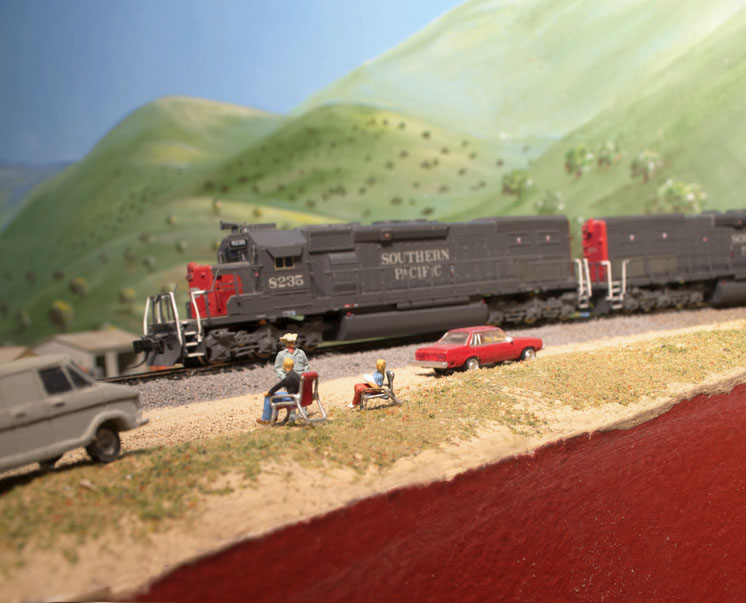
And this modern version of trains on steroids applies to equipment all up and down the line. The 40-foot boxcar was succeeded by the 50-footer, and now boxcars themselves are something of an endangered species, succeeded by containers on flatcars 89 feet long.
Given that the equipment to model today’s railroading is widely available, all this translates to N being a good choice.
The flip side of the coin
The biggest disadvantage of N scale, coincidentally, is also its small size. Railroad equipment dwarfs so much of what we find in the real world. N scale automobiles are only a little more than an inch long, and N scale people are really tiny. A 6-foot-tall man stands a little less than 1⁄2″ tall in N scale.
Getting some bang for your bucks
In N scale, we just have to work a little harder and be a bit more creative in making our little folks work for us. To get more impact out of figures, I usually place them on my N scale Tehachapi Pass layout in little groups of two or three, and talking, often next to a well-anchored vehicle or structure to help protect them from wayward actual-size fingers.
And speaking of protecting figures, one of my pet peeves is their skinny little ankles. It’s just too easy to literally knock them off their feet. That is to say, the bodies go flying while the feet stay glued down. I now fight this problem by gluing them with a more flexible adhesive, such as Aleene’s Tacky Glue or Woodland Scenics Hob-e-Tac. In the past I would use cyanoacrylate adhesive (CA) or Walthers Goo. Now my figures are more likely to bend than break.
One thing you can do to help figures stand out is to pose them against contrasting backgrounds – figures with dark clothing against something light, and vice versa. On occasion I’ve repainted their clothing to accomplish this.
Another useful trick is to place figures on props. A painter on a ladder is going to be quite visible, for example, especially if part of a wall near him is freshly painted and the rest isn’t.
Vertical separation between figures is also good, as in a man on the ground lifting a hay bale up to a guy in a pickup truck, or someone in a upper story window talking to someone on the ground.
A visiting friend, noted for his twisted sense of humor, once placed one of those little plastic wiring nuts over one of my railfan photographers standing by Tehachapi Loop, like a styrofoam cone to protect a tomato plant from frost. It was weeks before I noticed the little guy was hiding.
Even though those miniature citizens aren’t easy to spot, I’ve noticed that lay visitors to the layout often comment on them and enjoy them. The woman hanging washing on the line, the guy on crutches, the railfans at the loop sitting on lawn chairs, all these draw squeals of delight and declarations of “how cute.” You just have to get used to it.
Back when Gordon Odegard was working on Model Railroader’s N scale Clinchfield RR, he would drill a hole up into a figure’s leg, insert and glue in an extremely thin wire, and insert the wire into a tiny hole in the layout’s surface. This was especially handy when we wanted to move figures around for photographs.
I find the best figures in all the scales are those made by the German company Preiser. Its imaginative designers have a knack for figures that have great character. Woodland Scenics has also done fine work along these lines. It also offers neat little scenelets that sometimes involve interaction with vehicles. This is America, folks, and we like cars. Viewers are always drawn to interaction between figures and cars: washing them, looking under their hoods, even getting run over by them.
One last little observation about little N scale people. If they’re positioned logically and look like they belong where they are, you really don’t have to sweat the small stuff – like seasonal clothing. I’ve never had anyone ask why one figure is wearing a heavy jacket while another is in shorts.
This article originally appeared in the July 2016 Model Railroader – Ed.














Good article, just recently started back in N scale and will try the tacky glue. Not sure I could drill straight in those tiny little legs.
I’ve always liked the wire anchor for installing figures. Where the layout’s surface is foam the wire can simply be placed into the scenery like sticking a tack in a cork board. It makes it easy to place figures into the scene. Further it makes it easy to move them. Finally it avoids having the figures standing in a blob of glue.
/chris
I am new in n scale layout what and useing Kato what to
better use
Good column… while I did the “pin in the feet” in HO, I didn’t drill into the figure. I heated up a piece of wire and inserted that into the figure. I’m sure this trick came from MR way back (been reading since about 1960… Linn Wescott days) . Been using the Tacky Glue since I’ve moved to N, as you said, works well, and it’s easy to reposition the little people.